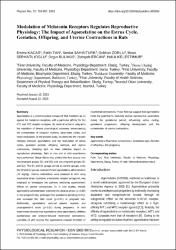Modulation of melatonin receptors regulates reproductive physiology: The impact of agomelatine on the estrus cycle, gestation, offspring, and uterine contractions in rats

Göster/
Erişim
info:eu-repo/semantics/openAccessTarih
2023Yazar
Kaçar, EmineTan, Fatih
Şahintürk, Serdar
Zorlu, Gökhan
Serhatlıoğlu, İhsan
Bulmuş, Özgür
Ercan, Zübeyde
Keleştimur, Haluk
Üst veri
Tüm öğe kaydını gösterÖzet
Agomelatine is a pharmaceutical compound that functions as an agonist for melatonin receptors, with a particular affinity for the MT1 and MT2 receptor subtypes. Its mode of action is integral to the regulation of diverse physiological processes, encompassing the orchestration of circadian rhythms, sleep-wake cycles, and mood modulation. In the present study, we delve into the intricate interplay between agomelatine and the modulation of estrus cycles, gestation periods, offspring numbers, and uterine contractions, shedding light on their collective impact on reproductive physiology. Both in vivo and in vitro experiments were performed. Wistar Albino rats, divided into four groups: two non-pregnant groups (D1 and D2) and two pregnant groups (G1 and G2). The D1 and G1 groups served as control groups, while the D2 and G2 groups received chronic agomelatine administration (10 mg/kg). Uterine contractions were assessed in vitro using myometrial strips. Luzindole, a melatonin receptor antagonist, was employed to investigate the pathway mediating agomelatine's effects on uterine contractions. In in vivo studies, chronic agomelatine administration extended the diestrus phase (p<0.05) in non-pregnant rats, prolonged the gestational period (p<0.01), and increased the fetal count (p<0.01) in pregnant rats. Additionally, agomelatine reduced plasma oxytocin and prostoglandin-E levels (p<0.01) during pregnancy. In vitro experiments showed that agomelatine dose-dependently inhibited spontaneous and oxytocin-induced myometrial contractions. Luzindole (2 mu M) reverse the agomelatine-induced inhibition of myometrial contractions. These findings suggest that agomelatine holds the potential to modulate diverse reproductive parameters during the gestational period, influencing estrus cycling, gestational progression, offspring development, and the orchestration of uterine contractions.

















